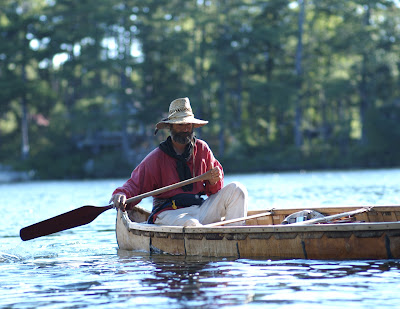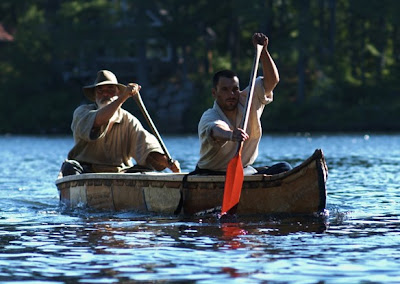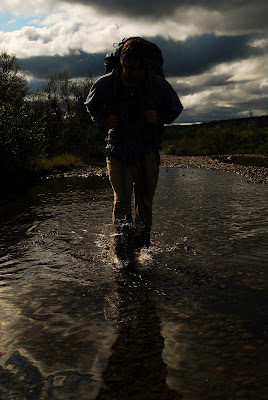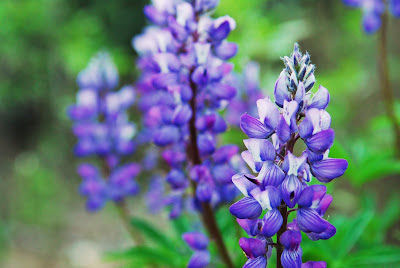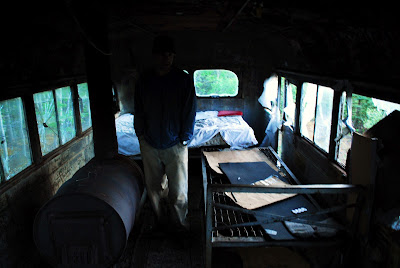
I was once a voyageur. It all started at the 2006 Alaska Tourism Convention in Valdez. I'd been working at Coldfoot Camp at the time, and my boss asked me if I wanted to go with him and a few other tour guides to the convention for a short vacation of sorts. One of the presenters was Bob Abrames, a former CEO of a tour company, a traveling motivational speaker, and a lover of voyageur history.
The voyageurs were Canadian traders of the 18th and 19th centuries who'd haul equipment to the frontier in the west and bring back furs to the villages in the east. In 2005, Bob had the great privilege of joining the "Destination NorOuest Expedition," which was a 100-day expedition along Canadian rivers and lakes filmed and produced by a French-Canadian film crew. He enjoyed the 2005 voyage so much that he bought a couple of birch bark canoes and started putting together expeditions of his own. At the convention, during his speech, he said he was looking for voyageurs to accompany him on his 2007 expedition--called the "Étienne Brûlé Expedition" during which he and three others would paddle the historic waterways of Canada for two months and 1,500 kilometers.
At the time, I was a recent college grad paying off my debt. Because I hadn't ever been on an adventure--minus a road trip to Alaska and a couple of small hikes in the Brooks Range--I was pretty excited about the prospect of joining him. I walked up to Bob after the speech and said, "Bob, I'm your man." Lots of other attendees said something similar, so he more or less forgot about me. But over the next 3-4 months, I pestered him with emails and began a rigorous workout routine to show him how serious I was. Eventually Bob gave in and said I could come.
We had two small birch bark canoes, ideal for a 4-person crew. But because Bob could only find two steady canoemates (myself and Jay), we had a fourth *random* person jump in every other week or so.
Here's Jay, a retired French teacher and voyageur enthusiast, who was my canoemate for the great bulk of the trip.
Here's Christian. He starred in the original 2005 DNO expedition with Bob. For personal and professional reasons, he couldn't accompany us the whole way, but he did spend about 3 weeks in total with us.
Art, who joined us for a week.
We began in Ottawa, Ontario. We head down the Rideau Canal, across the northern rim of Lake Ontario, up the Trent-Severn Canal, then up Georgian Bay, then along the French and Mattawa Rivers, and finally back down the Ottawa River to Ottawa, our starting point. We would try to average 32 kilometers a day, which was no simple feat considering how slow and leaky birch bark canoes are, which were hand-crafted my a master craftsman in Quebec, John Zeitoun.
Here's Bob and his son Casey, who joined us for part of the expedition. Bob funded and provided provisions, like the canoes, communal gear, and food. We were expected to buy our own clothes, paddle, and personal gear, which we bought from reenactment stores.
Bob and his sister, Sue, another replacement.
Lots of lounging in between hauls. Here we are at a canal lock.
French River, I think.

All our gear was "period-correct," meaning that we carried and wore the stuff and material that the voyageurs of the 18th century would have used (cotton and wool clothes, leather moccassins, straw hat, etc.) There were a few exceptions, like a camera, a cell phone, gps, and personal flotation devices we wore around our waists, which are required by law. We drank straight from rivers and lakes, but around cities and towns we purified our water with iodine tablets.
At night we'd store all our stuff under the canoes.
I was the unofficial cook and baker of the crew. Here I am making bannock in a couple of frying pans, which were greased with lard.
We slept with wool blankets above a hard cotton ground cloth. Our tarps were made with "egyptian cotton," which kept us dry, but were quite leaky by the end of the trip.
I am an exquisite napper, able to fall asleep in almost any circumstance, which I'd have to do to make up for all the sleep I lost at night because of the mosquitoes, which we had little protection from. Here I am lying on my ground tarp. My wool blankets are drying off in the distance.
Our fires were started with flint and steel. We'd catch the spark in something called "char," which is burnt cotton. We'd then shove the cotton into cedar shavings. Blow the shavings, and you have fire.
Diane, also a member of the original DNO crew, giving me a back massage.
Our other meal was salt pork and pea soup, which we ate for breakfast, lunch and dinner every day, and which I've never eaten again and probably never will. We also had salt, pepper, tea leaves, maple sugar, and dried cranberries.
Salt pork.
My bannock masterpiece.
We spent a whole day in a swamp called "La Vaz," which means "the mud" in French. (Correct me if I'm wrong, Francophiles.)
The vows that a voyageur makes at his baptism:
1. To obey the leader of the brigade.
2. To baptize any new voyageur at this point.
3. To not kiss any other voyageur's wife without her permission.
We carried our stuff in "bed rolls," which was all our stuff rolled up, which functioned as our seat in the canoe. Here's Jay, dropping his.
We had numerous portages during which we had to take two trips: the first with the canoes; the second with our bedrolls.
We carried our gear with "tumplines," which are leather straps that tie around your gear, and then your forehead. It feels about as uncomfortable as it looks in the picture below, though our portages were always a nice change of pace, because one's ass gets awfully sore in the canoe.
We completed the 1,500 km trip in two months, finishing in Ottawa, where we got a little press in the local newspapers.





